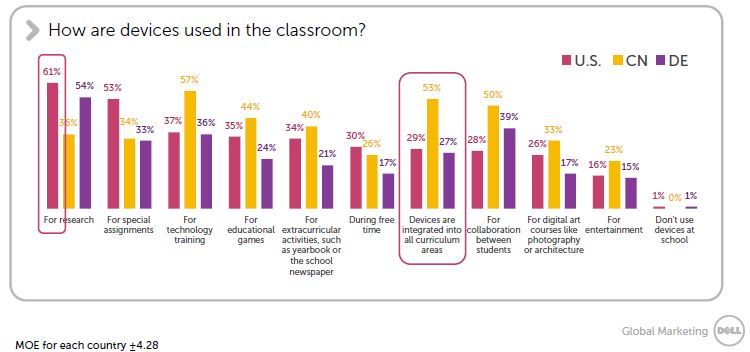Are learning and technology preferences impacting recruitment?
Recently, ICEF Monitor looked at how to appeal to the Chinese market by crafting marketing messages to reflect their propensity for luxury brands and experiences. Today, we explore the learning preferences of the Chinese, as well as the Americans and the Germans. The findings of a recent survey may surprise you, and if anything, will certainly inspire you to consider how well your marketing and recruitment efforts align with the type of learning environment your institution offers, as compared to the type a particular student (or parent) might prefer. A survey, commissioned by computer company Dell, has found that schools across the world are not meeting the educational technology needs of their students. But even more startling is the finding that China is ahead of the US and Germany when it comes to using technology in learning. Furthermore, many teachers in the US and Germany say they don’t receive enough technology training, particularly on how to integrate technology into the curriculum. Dell's "Innovation in Education" report is the result of 1,575 interviews with students, teachers and parents in the United States, Germany and China. Participants agree that technology is critical to learning, but have differing opinions about how best to use it in the classroom. The infographic below pulls out some of the contrasting trends between China and the US. Steve Felice, President and Chief Commercial Officer at Dell, commented on the survey findings:
"We heard from secondary school and university students, parents, and teachers that they are familiar and comfortable with technology, but don’t think it’s playing as large a role in the classroom as it should. Adults would like to see technology more integrated into learning. And, perhaps most importantly, many teachers do not feel as comfortable as their students do in using technology."
Technology in the classroom
The findings show that there is overwhelming support for using technology in the classroom, because it helps students prepare for future careers, but in the more immediate sense, it also helps students learn, gives them more access to teachers, and supports a more personalised learning experience.
That personal touch is particularly noteworthy coming from China, a country which has often been criticised for its over-reliance on rote learning.
And yet, China is the most likely to integrate technology into all curriculum areas - see the graph below for more details.
But despite being the heaviest users of technology in the classroom, most Chinese, like most respondents, still feel their needs are not being met, suggesting they are constantly hungry for more. This echos findings from several other surveys we covered in a previous article, "Students demanding more technology in education."
Chinese respondents also say they are more positive than their peers in the US and Germany about the use of social media in the classroom. About six in ten US respondents (students, teachers and parents alike) say they disapprove of students using social media in the classroom to share what they are learning, while more than 60% of respondents in China say they approve of social media for this purpose.
Regardless, one in four students say they access social media in the classroom daily.
Finally, most parents - particularly the Chinese - would be willing to pay for the technology their child uses in the classroom. This feedback opens up possibilities for tiered pricing models.

Opportunities to enhance teacher tech training
Many teachers in the US and Germany say they don’t receive enough technology training, for instance:
- The majority of teachers in all three countries say their students know how to use technology better than they do
- Students agree, with only 40% in the US and 26% in Germany saying their teacher knows how to use technology better than they do
- Teachers say core training focuses more on teaching practices (77%) and technology (55%) than on integration of technology in curriculum (55%) where it can make a greater impact
With regards to teacher training, we came across two interesting examples of how schools are empowering teachers to embrace technology and integrate devices into their day-to-day curriculum. The Jeannine Rainbolt College of Education at the University of Oklahoma has rolled out a pilot programme for the spring 2013 term that trains 575 students enrolled in the university’s undergraduate teacher education courses on how to use iPads for classroom work and for developing lesson plans. In the K-12 sector, the Fort Sam Houston Independent School District in San Antonio, Texas turned to the students themselves. By creating a team of student interns to instruct teachers on how to use technology effectively, they were able to give teachers face-to-face help from the students - who say it "makes them feel important" - as well as 24-7 access to online assistance. Not only has this created a supportive community environment, it also enabled them to train faculty on new technology tools while on a limited budget.
Technology at school vs. at home
When looking at how technology devices are used when not in school, interestingly, home devices are used primarily for school work. Globally, students say they use devices for school work more than any other activity (73%) - compared to entertainment games (65%), social media (63%), reading books (46%), and educational games (38%).
But only half of all students say they interact with their school online. Given the rising popularity of MOOCs, which exist entirely online, this could suggest that in order to remain a competitive option, traditional schools must incorporate more blended learning techniques.
The school day may have ended, but the learners - especially today's "always on" young learners - still seem keen to interact with the teacher. What will this mean for staffing in the brave new world of education?
Actions to meet technology needs
Some of the suggestions Dell offers in order to stay on track with the demands of both students and parents include:
- Eliminate access and skill barriers
- Innovate from the inside out by seeking feedback and ideas from current and prospective students, parents, alumni and teachers
- Adopt flexible, blended and personalised learning models that optimise teacher- and technology-delivered instruction in group and individual work
- Explore a role for social media in learning
- Support teachers with the skills, information and tools they need to enable students to manage their own learning at their own pace
- Invest in technical infrastructure that will adapt and scale as emerging technology-enabled models evolve and enrolment increases
- Use student and learning model performance data to modify learning approaches as necessary
Knowing students' and parents' desires for integrating more technology into the learning environment, we wonder, how are schools promoting their use of technology - both in terms of devices as well as in pedagogy? Feel free to share your examples in the Comments tab below, or tweet it to @icefmonitor.
















